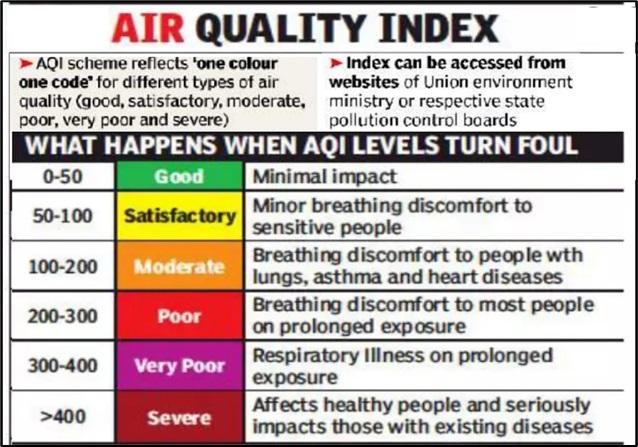| News Source: IE The air quality in Delhi turned ‘severe’ as its average AQI was 447 on January 14. The sudden deterioration in air quality prompted the Commission for Air Quality Management (CAQM) to invoke stage 3 measures under the Graded Response Action Plan (Grap) across Delhi-NCR with immediate effect. |
| For Mains: What is Air Quality Index (AQI)? What is Commission for Air Quality Management (CAQM)? What is Graded Response Action Plan (GRAP)? |
What is Air Quality Index (AQI)?
- AQI was launched in October 2014 to disseminate information on air quality in an easily understandable form for the general public.
- The measurement of air quality is based on eight pollutants, namely, PM10, PM2.5, NO2, SO2, CO, O3, NH3, and Pb
- The AQI transforms complex air quality data of various pollutants into a single number for ease of understanding.

What is Commission for Air Quality Management (CAQM)?
- CAQM is a statutory body formed under the Commission for Air Quality Management in National Capital Region and Adjoining Areas, Act 2021.
- The commission aims at better coordination, research, identification, and resolution of problems related to air quality in NCR and adjoining areas.
What is Graded Response Action Plan (GRAP)?
About
- GRAP is a set of emergency measures that kick in to prevent further deterioration of air quality once it reaches a certain threshold in the Delhi-NCR region.
- It was approved by the Supreme Court in 2016 and notified in 2017.
- The plan was formulated after several meetings between the Environment Pollution Prevention and Control Authority (EPCA), the state government, and experts.
- GRAP works only as an emergency measure.
- The plan does not include action by various state governments to be taken throughout the year to tackle industrial, vehicular, and combustion emissions.
Nature
- GRAP is incremental in nature and thus, when the air quality dips from ‘poor’ to ‘very poor,’ measures listed under both sections have to be followed.
| Stage 1 | of GRAP is activated when the AQI is in the ‘poor’ category (201 to 300) |
| Stage 1 | when it’s in the ‘Very poor’ category (301-400) |
| Stage 1 | when the AQI is the ‘Severe’ category (401-450) |
| Stage 4 | when it rises to the ‘Severe +’ category (more than 450). |

| A) What are Bharat Stage (BS) Emission standards? Bharat Stage (BS) Emission Standards are government-mandated standards that regulate the amount of air pollutants that motor vehicles emit. All vehicles sold and driven in India must comply with these standards. B) Suggestions for Improving AQI Management: Stringent Enforcement to ensure industries, vehicles, and construction activities comply with air quality standards. Strict penalties for violations can act as deterrents. Investment in Clean Technologies and Encourage the adoption of cleaner technologies in industries and promote the use of electric vehicles (FAME Yojna) to reduce emissions at the source. Urban Planning and Green Spaces: Implement sustainable urban planning, enhance public transportation, and create green spaces. Trees and plants can act as natural air purifiers. Public Participation and awareness campaigns: Involve the public in air quality management through awareness campaigns, citizen science initiatives, and feedback mechanisms. Public engagement can lead to more responsible behavior and support for pollution control measures. Research and Innovation: Invest in research and development to identify new technologies and innovative solutions for air quality improvement. C) Impactful Ways In Which You Can Reduce Air Pollution 1. Walk or ride a bike whenever possible 2. Recycle and reuse items 3. Consistently practice tree planting 4. Use organic products 5. Regularly maintain your car 6. Purchase and opt for green electricity at all times 7. Quit smoking 8. Only use Energy Star appliances 9. Do not use harmful chemicals 10. Need for Climate-Smart Agriculture in India |
Conclusion:
The Indian government’s role in managing the Air Quality Index is critical for safeguarding public health and the environment.
Collaborative efforts involving government, industry, and the public are essential to achieving sustainable improvements in air quality
